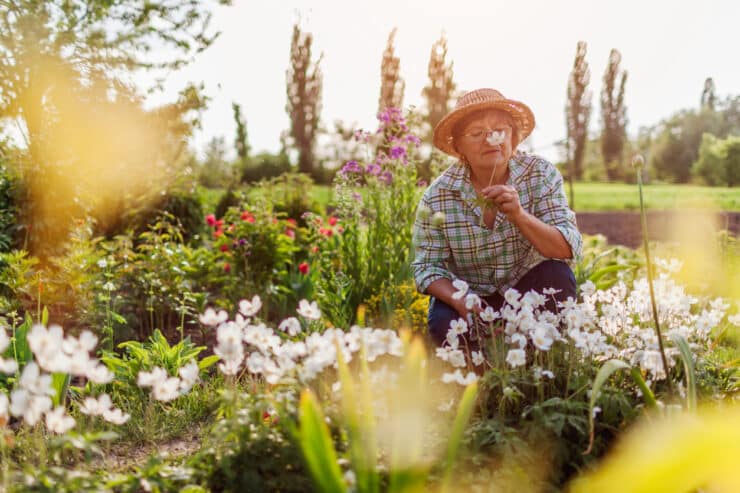Retirement is a milestone that many look forward to — finally having the time to relax, pursue hobbies, and enjoy the little things in life. For many, the backyard becomes a sanctuary where they can unwind and savor the peace that comes with this new chapter.
Imagine spending slow mornings on the patio with a cup of coffee and a good book, inviting friends over for a casual game of bocce ball, or enjoying a cozy chat around the fire. A hot tub could be your go-to spot for soaking away the day’s worries and enjoying some well-deserved relaxation.
But as much as you’d love a beautiful garden to be part of your backyard oasis, you don’t want your newfound free time to be consumed by endless yard work.
That’s where low-maintenance landscaping comes in. From hardy plants to automated watering systems, container gardens to an outdoor hot tub, these backyard ideas will help you create a space that’s as easy to care for as it is enjoyable.

7 low-maintenance landscaping ideas for retirees
Gardening is a favorite hobby for many, and it often becomes even more enjoyable when retirement rolls around. In fact, about 40% of home gardeners in the U.S. are over age 50, according to the National Gardening Association.
With the end of a busy work life, retirement offers the perfect chance to spend more time in nature and enjoy the gardening experience.
A lush, flourishing garden with vibrant colors and thriving plants can be a sense of pride for some retirees. However, you don’t have to create an elaborate garden that requires daily maintenance. There are low-maintenance landscaping ideas that will enhance your backyard space and make it easier to enjoy.
1. Choose hardy, low-maintenance plants
When it comes to creating a low-maintenance garden, plant choice is key. Opt for plants that thrive in your region and require minimal care. Native plants are an excellent choice as they are adapted to the local climate, soil, and pests, meaning they’ll need less water, fertilizer, and attention compared to non-native species.
For example, in a sunny area, you might consider planting lavender, a hardy perennial known for its drought tolerance and lovely fragrance. Ornamental grasses like blue fescue or feather reed grass add texture and movement to your garden without needing much water or pruning. Hostas are another great option, especially for shaded areas; they offer lush foliage with minimal care.
For those in cooler regions, such as zones 4 to 6, consider low-maintenance plants like sedum and coneflower. Sedum, also known as stonecrop, is a resilient succulent that thrives in poor soil and requires little water. Coneflowers, with their vibrant blooms, are both drought-tolerant and cold-hardy, making them perfect for adding color to your garden with minimal effort.
Bonus: Many low-maintenance plants are also beneficial for pollinators, bringing more life and activity to your garden with minimal effort on your part.
2. Mulch for moisture and weed control
Mulching is one of the simplest yet most effective ways to reduce garden maintenance. A thick layer of organic mulch around your plants helps retain soil moisture, which means less frequent watering is required. Mulch also suppresses weed growth by blocking sunlight from reaching weed seeds, reducing the time you spend pulling weeds.
In addition to its practical benefits, mulch adds a finished look to your garden beds, enhancing your overall landscape. Organic mulches, like wood chips, bark, or compost, gradually break down and enrich the soil, providing nutrients to your plants over time. Replenish the mulch once a year, and your garden will continue to thrive with minimal effort.
To maximize the effectiveness of mulch, apply it generously — about 2 to 4 inches deep — around your plants, making sure to keep it away from the base of the stems to prevent rot.
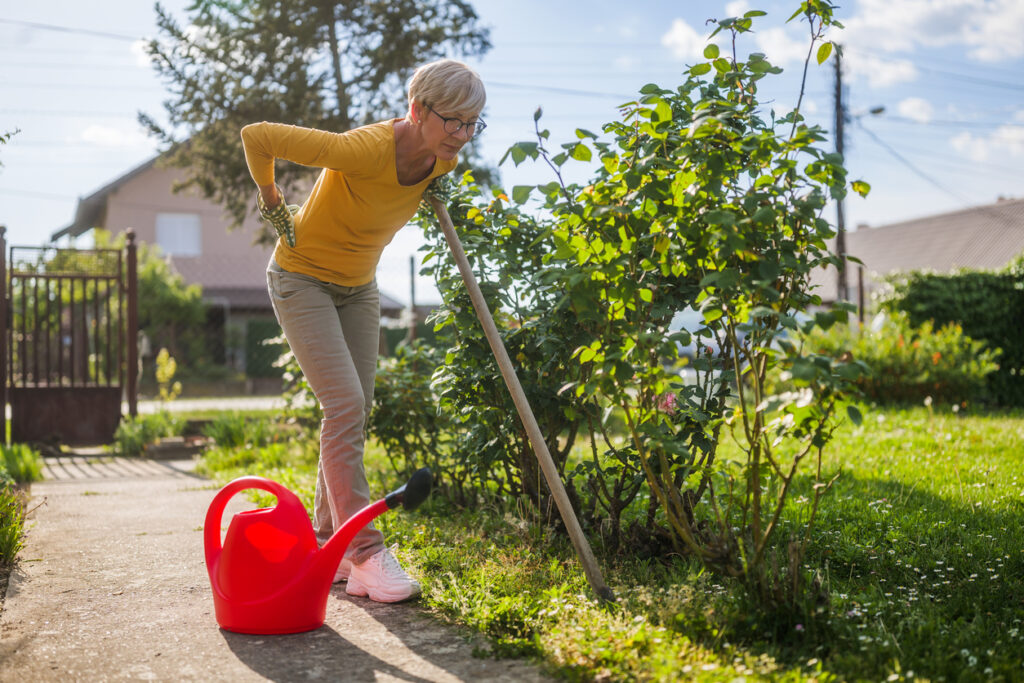
3. Invest in automatic irrigation systems
Watering the garden can be a time-consuming task, especially during hot summer months. You have to drag out the hose around the yard, and there always seems to be a kink in the line impeding your progress.
An automatic irrigation system takes this chore off your hands, ensuring your plants receive the water they need. These systems, albeit expensive, allow you to consistently water your plants and lawn while conserving water.
Drip irrigation and soaker hoses are excellent choices for efficient watering. These systems deliver water directly to the base of your plants, minimizing waste and reducing the likelihood of overwatering. Plus, with drip systems that can be set on timers, you can water your garden at optimal times, such as early morning or late evening, when evaporation rates are lower.
4. Incorporate hardscaping for structure and style
Hardscaping elements, such as stone paths, gravel beds, and raised planters, can significantly reduce the amount of maintenance your garden requires. These features add structure and visual interest to your landscape while minimizing the need for constant care.
Stone or gravel paths, for example, eliminate the need for mowing and can be used to create defined walkways that guide visitors through your garden. Raised planters not only add height and dimension to your landscape but also make gardening more accessible, reducing the need to bend or kneel while tending to your plants.
Patios and decks are other hardscaping options that provide space for outdoor furniture or a backyard hot tub, enhancing your ability to enjoy your garden without the upkeep associated with grass or other ground covers.
5. Opt for low-maintenance ground covers
Traditional lawns can be one of the most labor-intensive parts of a garden, requiring regular mowing, watering, and fertilizing. If you’re looking to reduce the time and effort spent on lawn care, consider replacing all or part of your lawn with low-maintenance ground covers.
Ground covers like creeping thyme, clover, or sedum are excellent alternatives to grass. These plants are drought-tolerant, require minimal mowing, and add texture and color to your landscape. Creeping thyme, for example, forms a dense mat of green that bursts into purple blooms in the summer, creating a visually appealing, fragrant carpet that’s also functional. Clover is another great option. It stays green throughout the year, fixes nitrogen in the soil, and is soft underfoot, making it perfect for areas where you might want to walk barefoot.
These ground covers can be used to create a soft, inviting space around your hot tub, where you can enjoy the natural beauty of your garden without the hassle of maintaining a traditional lawn. Plus, they contribute to the overall health of your garden by improving soil quality and attracting beneficial insects.
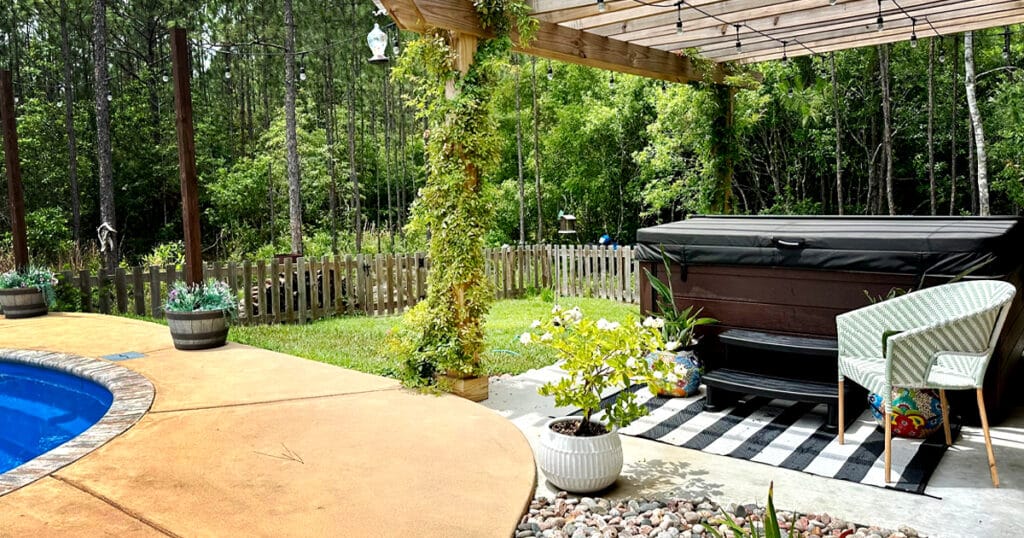
6. Add container gardens for flexibility
Container gardening is a versatile and low-maintenance option for adding greenery to your outdoor space. By planting in containers, you can control the soil quality, moisture levels, and plant placement more easily than in traditional garden beds.
Containers can be moved around to take advantage of changing sunlight or to protect plants from extreme weather conditions. This flexibility allows you to experiment with different plants and arrangements without the commitment of planting in the ground. Plus, container gardens are easier to maintain; watering, feeding, and pruning are all simplified when plants are contained.
Choose a variety of container sizes, shapes, and materials to create an interesting and dynamic display. Consider using containers made of durable materials like terracotta, ceramic, or metal that can withstand the elements and require minimal upkeep. Container gardens are perfect for adding color and interest to patios, decks, or near your hot tub, creating a lush and vibrant atmosphere with minimal effort.
7. Incorporate drought-tolerant plants
To make your garden even easier to care for, consider incorporating drought-tolerant plants. These hardy varieties require less water and are well-suited to withstand hot, dry conditions, making them ideal for low-maintenance landscaping.
Drought-tolerant plants, such as succulents and ornamental grasses, thrive with minimal water. They’re perfect for reducing the overall water needs of your garden and can help lower your utility bills. These plants also add unique textures and colors to your garden, enhancing its visual appeal while saving you time and effort.
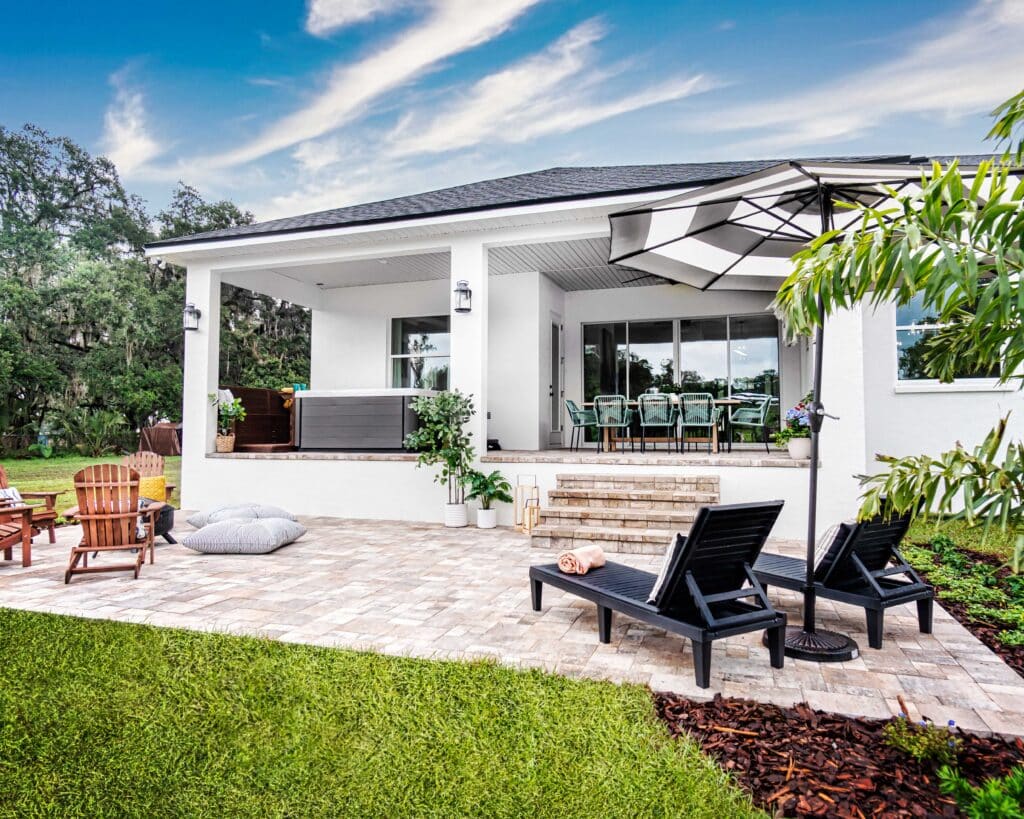
Integrate a hot tub into your low-maintenance landscape
While your garden’s primary focus might be on ease of care and relaxation, a hot tub can be a valuable addition to your backyard retreat. Not only does it offer a place to unwind and enjoy the health benefits of hydrotherapy, but it can also be seamlessly integrated into your low-maintenance landscape.
Hot tub placement
The first step in integrating a hot tub into your garden is choosing the right location. Consider placing your hot tub near existing hardscaping features, such as a patio or deck, to minimize the need for additional construction. Surrounding your hot tub with low-maintenance plants or ground covers, as discussed earlier, can help it blend naturally into the landscape while minimizing upkeep.
For privacy, consider using tall, dense plants, like bamboo or ornamental grasses, to create a natural screen. You can also incorporate trellises with climbing vines, like clematis or jasmine, which add a vertical element to your garden while providing a fragrant, visual barrier.
Year-round enjoyment
One of the great advantages of owning a hot tub is that it can be enjoyed all year long, regardless of the season. Master Spas hot tubs are designed with energy-efficient foam insulation and a snug-fitting cover, ensuring that heat stays in and the elements stay out.
In the warmer months, your hot tub serves as a luxurious complement to your garden, allowing you to soak in the beauty of your landscape while relaxing in soothing water. When the temperature drops, your hot tub becomes a cozy retreat, offering a warm escape from the chill. With the ability to set the water temperature up to 104 degrees, you can easily adjust the heat to match the season or your personal comfort level, ensuring that your hot tub experience is always just right.
To enhance the wintertime experience, consider adding evergreens or winter-blooming plants around your hot tub to maintain visual interest even when other parts of your garden are dormant.
Health benefits of a hot tub
Beyond its aesthetic appeal, a hot tub offers numerous health benefits, particularly for those in their retirement years. Regular use of a hot tub can help ease aches and pains, improve circulation, and promote better sleep. The warm water and massage jets provide hydrotherapy, which can be especially beneficial for relieving joint pain, muscle tension, and stress.
For retirees who love gardening, the StressRelief Neck and Shoulder Seat from Master Spas offers much-needed relief after a day spent tending to plants. The strategically placed jets target the neck and shoulders, areas where tension often builds from bending and lifting.
By incorporating a hot tub into your low-maintenance landscape, you’re not only enhancing your outdoor space but also investing in your well-being.
Minimal maintenance
Master Spas hot tubs are designed with ease of use and maintenance in mind, making them a practical addition to a low-maintenance garden. With an advanced filtration system that requires less chemicals than other systems, you will spend less effort on keeping the water balanced and more time relaxing in front of the massage jets. With a well-planned setup and routine care, maintaining your hot tub can be as simple as tending to the low-maintenance elements of your garden.
Retirement is your time to relax, enjoy the beauty of your surroundings, and focus on the activities you love. By implementing these seven low-maintenance landscaping ideas, you can create a backyard that’s as easy to care for as it is enjoyable. From selecting hardy plants and using mulch to incorporating hardscaping and a backyard hot tub, each of these strategies is designed to help you spend more time relaxing and less time working.
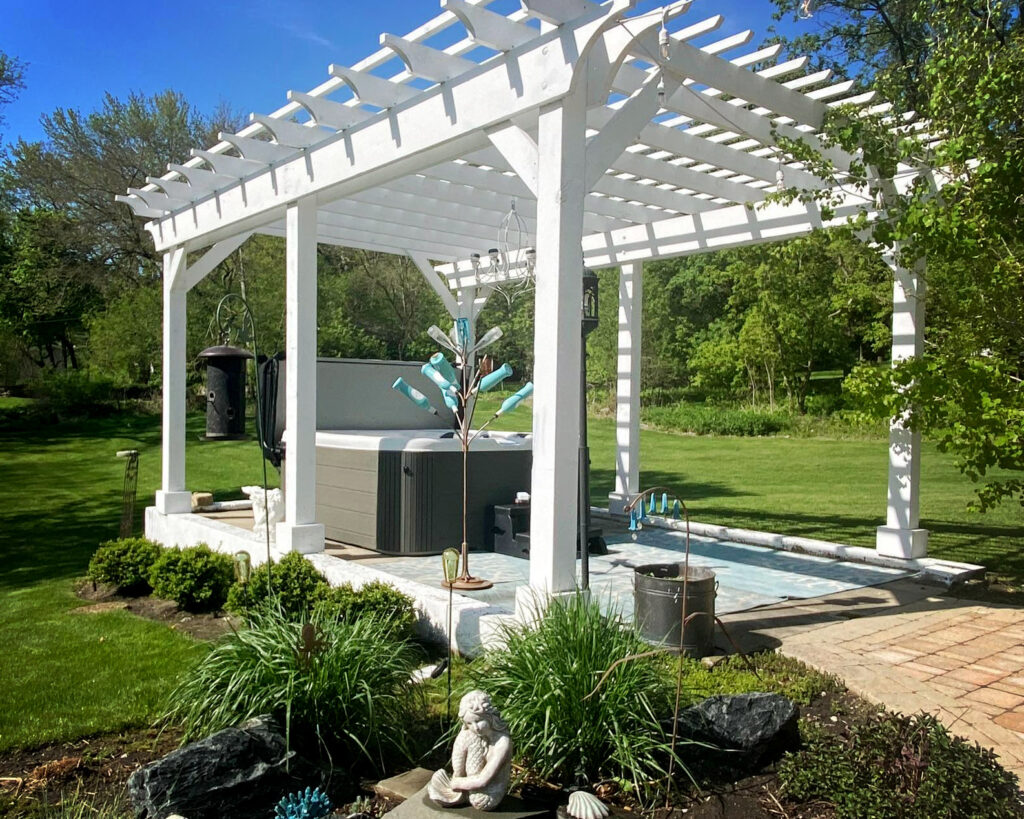
Buy an all-season hot tub
Are you ready to invest in your well-being and backyard? Master Spas hot tubs can be enjoyed this year and many years to come. Click here to learn more about the benefits of hydrotherapy. Or, contact your local Master Spas retailer to learn more about hot tub ownership. Wondering how much a Master Spas hot tub costs? You can request a quote here.


